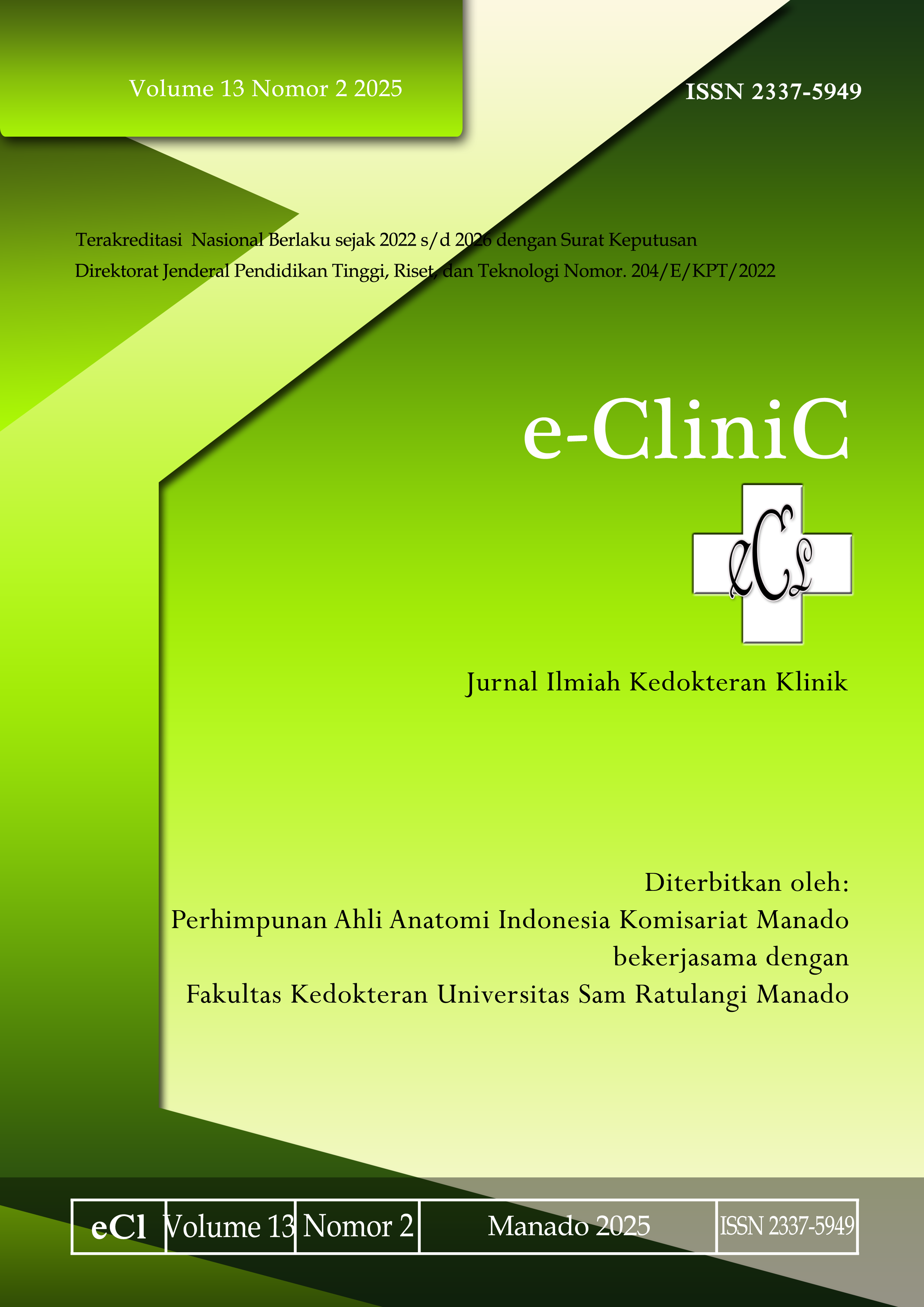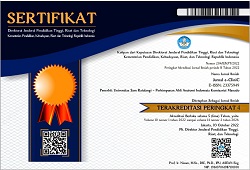Hubungan Tipe Fistula, Waktu Operasi, dan Toilet Training pada Malformasi Anorektal dengan Pola Defekasi Pascaoperasi Berdasarkan Skor Rintala
DOI:
https://doi.org/10.35790/ecl.v13i2.61271Abstract
Abstract: Anorectal malformation is a congenital abnormality in which the anus does not open normally into the perineum. In several studies, earlier surgery time has a better impact on patients. Toilet training performed postoperatively is assumed to help improve patient defecation patterns. This study is an observational analytical study with a retrospective cohort design. The population in this study were pediatric patients after surgery for Anorectal Malformation based on the Wingspread classification at Prof. R.D. Kandou General Hospital, Manado. The independent variables were fistula type, surgery time, and toilet training. In this study, the dependent variable was postoperative defecation pattern based on the Rintala Score. Bivariate analysis was used to analyze the relationship between independent variables and dependent variables. The Somers' D test was used to measure the relationship between categorical variables. The results showed that the variables namely fistula type, surgery time, and toilet training in anorectal malformation did not have statistically significant relationships with postoperative defecation pattern based on the Rintala score (p-value >0.05). The Rintala score does not always describe the anatomical or functional conditions of the anus in detail. In conclusion, there is no significant relationship between fistula type, surgery time, and toilet training in anorectal malformation with postoperative defecation pattern based on the Rintala score.
Keywords: anorectal malformation; fistula type; surgery time; toilet training; Rintala score
Abstrak: Malformasi anorektal merupakan sebagai salah satu kelainan bawaan dengan kondisi anus tidak membuka secara normal ke perineum. Toilet training yang dilakukan pascaoperasi diasumsikan membantu memperbaiki pola defekasi pasien. Penelitian ini bertujuan untuk mengevaluasi hubungan antara tipe fistula, waktu operasi, dan toilet training pada malformasi anorektal dengan pola defekasi pascaoperasi berdasarkan skor Rintala. Jenis penelitian ialah analitik observasional dengan desain kohort retrospektif. Populasi penelitian ialah pasien anak pascaoperasi malformasi anorektal berdasarkan klasifikasi Wingspread di RSUP Prof. Dr. R. D. Kandou Manado. Variabel bebas ialah tipe fistula, waktu operasi, dan toilet training sedangkan variabel terikat ialah pola defekasi paska operasi berdasarkan Skor Rintala. Analisis bivariat digunakan untuk menganalisis hubungan kedua variabel, dan uji Somers’D untuk mengukur hubungan variabel kategori. Hasil penelitian ini yaitu variabel tipe fistula, waktu operasi, dan toilet training pada malformasi anorektal tidak berhubungan bermakna secara statistik dengan pola defekasi pascaoperasi berdasarkan skor Rintala (p>0,05). Skor Rintala tidak selalu menggambarkan kondisi anatomis atau fungsional anus secara rinci. Simpulan penelitian ini ialah tidak terdapat hubungan bermakna antara tipe fistula, waktu operasi, dan toilet training pada malformasi anorektal dengan pola defekasi pascaoperasi berdasarkan skor Rintala.
Kata kunci: malformasi anorektal; tipe fistula; waktu operasi; toilet training; skor Rintala
References
Ghorbanpoor M, Dehvan B, Rahimi S, Pirdehghan A. Fecal Incontinence after posterior sagittal anorectoplasty for anorectal malformation: a single-center study. Scientifica. 2018;1(2):1–4. Doi:10.1155/2018/8297617
Levitt MA, Peña A. Imperforate anus and cloacal malformations (Chapter 36). In: Holcomb GW, Murphy JP, Ostlie DJ, editors. Ashcraft’s Pediatric Surgery. Elsevier Saunders; 2010. p. 468–90. Doi:10.1016/b978-1-4160-6127-4.00036-7
Masdar H, Wahid R, Putri G, Angka keberhasilan posterosagittal anorectoplasty (PSARP) yang dinilai dari skor Klotz pada pasien malformasi anorektal dibangsal bedah RSUD Arifin Achmad Provinsi Riau periode Januari 2009 - Desember 2014. Jurnal Online Mahasiswa Fakultas Kedokteran. 2014;1(2):1-8. Available from: https://www.neliti.com/publications/186937/angka-keberhasilan-posterosagittal- anorectoplasty-psarp-yang-dinilai-dari-skor-k
Maerzheuser S, Schmidt D, Mau H, Winter S. Prospective evaluation of comorbidity and psychosocial need in children and adolescents with anorectal malformation. Part one: paediatric surgical evaluation and treatment of defecating disorder. Pediatr Surg Int. 2009;25(10):889–93. Doi:10.1007/s00383-009-2440-9
Hassett S, Snell S, Hughes-Thomas A, Holmes K. 10-year outcome of children born with anorectal malformation, treated by posterior sagittal anorectoplasty, assessed according to the Krickenbeck classification. J Pediatr Surg. 2009;44(2):399–403. Doi: 10.1016/j.jpedsurg.2008.10.092
Behrman RE, Kliegman RM, Arvin AM. Ilmu Kesehatan Anak Nelson (15th ed). Wahab AS, editor. Jakarta: EGC; 2010. p.1322-5.
Sadler TW. Langman’s Medical Embryology: System-Based Embryology: Muscular System, Respiratory System, Urogenital System (11th ed). Philadelphia: Lippincott Williams &Wilkins; 2010. p :789-91
Rintala RJ, Pakarinen MP. Imperforate anus: long- and short-term outcome. Semin Pediatr Surg. 2008;17(2):79–89. Doi: 10.1053/j.sempedsurg.2008.02.003
Goyal A, Williams JM, Kenny SE, Lwin R, Baillie CT, Lamont GL, et al. Functional outcome and quality of life in anorectal malformations. J Pediatr Surg. 2006;41(2):318–22. Doi: 10.1016/j.jpedsurg.2005.11.006
Danielson J, Karlbom U, Graf W, Wester T. Outcome in adults with anorectal malformations in relation to modern classification — Which patients do we need to follow beyond childhood? J Pediatr Surg. 2017;52(3):463–8. Doi: 10.1016/j.jpedsurg.2016.10.051
Arnoldi R, Macchini F, Gentilino V, Farris G, Morandi A, Brisighelli G, et al. Anorectal malformations with good prognosis: Variables affecting the functional outcome. J Pediatr Surg. 2014;49(8), 1232–6. Doi: 10.1016/j.jpedsurg.2014.01.051
Pena A. Atlas of Surgical Management of Anorectal Malformations. New York: Springer-Verlag; 1990.
Thapa B, Basnet B, Pun M, Thapa A. Management of ano-rectal malformations in a tertiary level children’s hospital of Nepal. Journal of Nepal Paediatric Society. 2013;33(3). Doi: 10.3126/jnps.v33i3.8190
Hidayat AA. Pengantar Ilmu Keperawatan Anak. Jakarta: Salemba Medika; 2007. p. 50-5.
Stenström P, Kockum CC, Emblem R, Arnbjörnsson E, Bjørnland K. Bowel symptoms in children with anorectal malformation — a follow-up with a gender and age perspective. J Pediatr Surg. 2014;49(7):1122–30. Doi: 10.1016/j.jpedsurg.2013.10.022
Kyrklund K, Pakarinen MP, Taskinen S, Rintala RJ. Bowel function and lower urinary tract symptoms in females with anterior anus treated conservatively: controlled outcomes into adulthood. J Pediatr Surg. 2015;50(7):1168–73. Doi: 10.1016/j.jpedsurg.2014.09.074
Downloads
Published
How to Cite
Issue
Section
License
Copyright (c) 2025 Sabrandi P. Saputra, Harsali F. Lampus, Candy Candy

This work is licensed under a Creative Commons Attribution-NonCommercial 4.0 International License.
COPYRIGHT
Authors who publish with this journal agree to the following terms:
Authors hold their copyright and grant this journal the privilege of first publication, with the work simultaneously licensed under a Creative Commons Attribution License that permits others to impart the work with an acknowledgment of the work's origin and initial publication by this journal.
Authors can enter into separate or additional contractual arrangements for the non-exclusive distribution of the journal's published version of the work (for example, post it to an institutional repository or publish it in a book), with an acknowledgment of its underlying publication in this journal.
Authors are permitted and encouraged to post their work online (for example, in institutional repositories or on their website) as it can lead to productive exchanges, as well as earlier and greater citation of the published work (See The Effect of Open Access).







